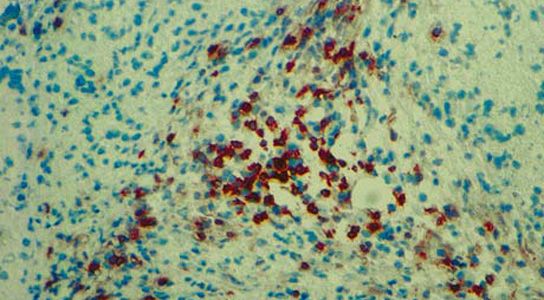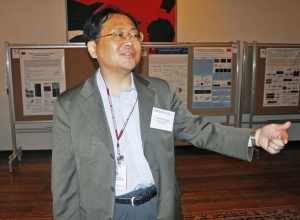Hisashi Moriguchi’s Stem-Cell Transplant Claims Refuted
October 16, 2012

Immune cells infiltrate tissue grown from induced pluripotent stem cells. Photograph: Yang Xu/UC San Diego
Just days after Kyoto University biologist Shinya Yamanaka won the Nobel Prize for his discovery of induced pluripotent stem cells (iPS), Hisashi Moriguchi, a visiting researcher at the University of Tokyo, claimed to have modified that technology to treat a person with terminal heart failure. Eight months after the treatment, the patient was reported to be healthy.
After learning about this story, Harvard Medical School and Massachusetts General Hospital (MGH), where Moriguchi claimed to have done the work, denied that it had ever happened. There were no clinical trials relating to Moriguchi’s work approved by an institutional review board, either at Harvard or MGH, states David Cameron, spokesman for the Harvard Medical School in Boston. Another public affairs official at MGH states that the work wasn’t done there either.

Hisashi Moriguchi presented his work at the New York Stem Cell Foundation meeting this week.
Moriguchi claimed to have invented a method to reprogram cell using a microRNA-145 inhibitor and a TGF-β ligand. However, Hiromitsu Nakauchi, a stem-cell researcher at the University of Tokyo, states that he has never heard of success with that method and hadn’t heard of Moriguchi before this week. Moriguchi also claimed that the cells could be differentiated into cardiac cells, using a “supercooling” method he invented.
The article in which Moriguchi presented his findings, which was published in a book describing advances in stem-cell research, includes plagiarized paragraphs from other papers with only the institution names changed. Moriguchi stands by his publication, stating that he did use other papers as a reference.
Moriguchi is also quite vague about his supercooling technique, stating that it’s identical to a paper he published in Scientific Reports, which describes the supercooling of ovaries for preservation, not for differentiation of iPS cells into cardiac cells
Moriguchi also claims that he did most of the contentious work himself. While some other researchers were involved, he wouldn’t provide any names.
To Nature, he claimed that he had learned the necessary surgical techniques while earning a medical degree at the Tokyo Medical and Dental University, but today he changed his story, saying that he had a nursing degree, not a medical degree.
While he did hold a position at the University of Tokyo from 2006 to 2009, during which he studied medical economics and the evaluation of clinical technologies, he is currently a visiting researcher at the same university, working in Makoto Mihara’s lab, in the cosmetic-surgery section, where he comes in once or twice a week. He was a visiting fellow at MGH and Harvard Medical School, in 1999-2000, but hasn’t been associated with them since.
When questioned further about his iPS cell procedures, like who funded them and where they took place, Moriguchi again referred to MGH and Harvard Medical School.
No comments:
Post a Comment